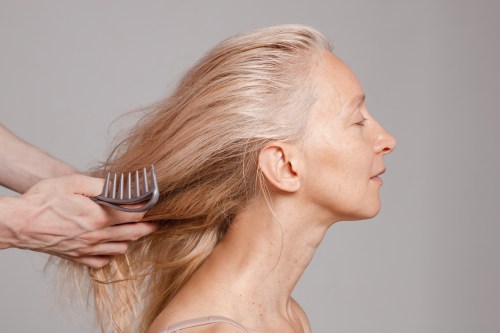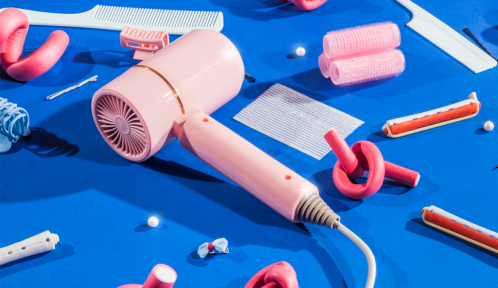Our editors independently select these products. Making a purchase through our links may earn Well+Good a commission
TMI, but Uh, How Do I Give My Own Butt a Brazilian Bikini Wax?
An expert explains how to wax your butt strip on your own for an at-home Brazilian, plus how to prevent ingrown hairs afterwards.

What you choose to do with your body hair is your personal choice, but the bravest among us are the ones who choose to DIY their Brazilian bikini waxes at home. These people, IMO, are the real fearless. But even if you’re one of the select few who has somehow mastered the art of ripping stubble from your bikini area without screaming, things can get quite a bit more complicated when you flip over for the sake of going fully bare down there. Between the hand-eye coordination required to get it right and the pain, waxing your own butt strip is truly an act of valor.
Experts in This Article
anal surgeon and founder of Bespoke Surgical and Future Method
brand expert and ambassador at Nad’s
For the uninitiated, a”Brazilian” is a waxing treatment that leaves your nether regions totally hairless from front to back. “A Brazilian wax treatment removes all hair from your bikini or pubic area—the top, sides, and front—and those hard-to-reach areas in the back,” says Natalie Ismiel, Nad’s brand expert.
“Hard to reach” is the keyword here. It’s tough to tackle a spot where the sun don’t shine with nothing more than your own two hands and a prayer, but it is possible with the right techniques. Keep scrolling for everything you need to know about how to wax your butt, then wash your hands and get to work.
How to wax your butt strip
1. Get the right products
There are hundreds of DIY waxing kits on the market, but not all of them are private-part friendly. Ismiel notes the importance of seeking out products that explicitly say they’re for Brazilian waxes to ensure you’ve got a formula that’s gentle enough to be used in those sensitive areas. “Test a small patch of skin to ensure that you don’t have any adverse reactions,” she suggests. There are a few different types of waxes you can go for, all of which come with their own pros and cons.
Soft wax
Soft wax has a liquid-y texture, and is meant to be applied with a wooden spatula and removed with a strip. It’s faster to prep than hard wax, but comes with more potential to cause irritation because it adheres to the hair and the skin underneath. This means that you’ll need to be extra careful about going over the same area twice in a single DIY waxing session, because it comes with a very real risk of accidentally ripping off the top layer of your skin.
“With soft wax you need to be careful how you apply it, especially with the direction to the hair, as the wrong way can distort the hair follicle,” Diedra Green, field training manager at European Wax Center says, adding that soft wax can permanently alter your hair follicles if applied and removed incorrectly. There aren’t a ton of Brazilian-friendly DIY options on the market in the soft wax category (and none of them look particularly legit), so plan to stick with one of the other two options instead.
Hard wax
Like soft wax, hard wax starts as a liquid and is applied to the skin using a wooden spatula. After a few seconds, it dries into a solid, and doesn’t require a strip to remove—you can just pull it right off, and the hair will come along with it. It’s less irritating than its soft counterpart and can be applied and removed in any direction without any risk of damaging your skin, which is a definite plus. “Hard wax is strong enough to remove the coarsest hair in the most sensitive areas,” says Green. Generally speaking, estheticians prefer hard wax, but ultimately the choice is up to you.
Waxing strips
If you’re new to waxing, strips are going to be your best bet. They come pre-coated in wax and require very little prep—simply stick them onto the hair you want to remove, apply firm pressure, and rip them off. Though strips are fairly easy to use, they require a bit of trial and error—so you may want to test them out somewhere less sensitive before going in on your butt cheeks. They’re also less sticky than other types of wax, so may require a few passes to get rid of *all* the hair down there.
2. Make sure your hair is long enough for waxing
Generally speaking, hair should be at least a quarter of an inch long before you wax it off. If it’s any shorter than that, the wax will have a hard time gripping the strands and the whole thing won’t work. Since you likely aren’t measuring the hair between your cheeks, plan to wait four weeks between your waxes to give it enough time to grow in.
3. Prep your skin
First things first: Before your wax, it’s important to clean your butt. That means hopping in the shower and using a gentle yet effective soap in order to keep the sensitive area irritation-free. According to Evan Goldstein, DO, a New York City-based anal surgeon, there are a few things people tend to get wrong when it comes to keeping their behind’s clean—which is even more of an issue when you’re going to be experimenting with hot wax. “Just like you have rituals for the face, we should really be approaching the butt in the same way. It doesn’t have to be complicated,” says Dr. Goldstein.
In addition to using the right products, it’s also important to ensure the area is totally dry when you step out of the shower. “If you don’t dry yourself off completely [after a shower], the moisture is then sitting between your cheeks,” says Dr. Goldstein. “When it’s not dry, you’re sitting all day long or all night with excess moisture, which can lead to a significant amount of issues.” These issues include bacterial infections, fungal infections, dermatitis, rashes, and micro-tears—none of which you want anywhere near hot wax.
4. Prep your wax
There are a few different types of wax that can be used for a Brazilian, so your prep process will largely depend on what you’re working with. With soft and hard wax, you’ll want to keep the products warm and stir regularly before you apply to ensure you’re getting the best results, and with strips, you may need to heat them up in your hands. If there’s one time in your life when you’re *actually* going to read the directions, this is it.
5. Figure out your position
As you may imagine, this is the trickiest part of all. To get to all those hard-to-reach spots, Ismiel says that you may have to change positions a couple of times—but thankfully, there are options.
“Try standing while propping one leg up on a bathtub or chair,” she suggests. “Stand in front of a mirror or have a hand mirror, so that you can give yourself extra visibility. If you have trouble reaching, you can also lay in front of a standing mirror while bending your knees and spreading your legs widely while propping up your lower back with a pillow.” Find out what is the most comfortable for you and get to work.
6. Wax wisely
First things first: You can absolutely pop an Advil (or any other anti-inflammatory pain reliever) before you submit yourself to this kind of torture. Not only will it make the whole thing hurt less, but it will also limit the inflammation in your skin post-treatment. Additionally, try to avoid waxing five days before or after your period, as the area will be more sensitive in the days around your cycle.
Now, for the fun stuff. “Wax should always be applied in the direction of the hair growth, so if your hair grows in two different directions, you’ll need to treat it in two sections,” says Ismiel. While this isn’t *as* important with some types of wax (it’s a non-negotiable for soft wax, but less so for hard wax and strips), it’s still a good practice to keep up with.
Her pro tip: Hold the skin taut with one hand when removing the wax, and keep the wax as close to the skin as possible when removing it. “Don’t pull in an upward direction, as this will simply pull the skin and not the hair,” she says.
7. Try to stay calm
Yes, you may be waxing your pubic area and your butt strip, but it’s key to try and relax as much as humanly possible.
“Take deep breaths and relax your body,” says Ismiel. “You’ll find that every wax after that gets easier and less painful.” She suggests avoiding too much alcohol or caffeine right before waxing, as it “can tighten your pores and feel more painful.” And avoid doing this while you’re on your period, because you’ll be more sensitive and prone to extra discomfort.
8. Pamper the area
Once the hair is gone and you’ve breathed a sigh of relief, it’s time to give your skin a little TLC. Start by cleaning up any excess wax. Many kits come with wipes, but you can also use a cotton pad dipped in a hydrating liquid—just make sure you’re using a labia-friendly formula (this one from Fur serves double duty in preventing ingrowns, but any old castor oil will do). Apply some aloe to reduce redness and inflammation and a hydrating serum to nourish the area, and let it dry before getting dressed.
If you can, plan your wax for a time when you can immediately slip into something more comfortable when it’s over—it’s best to let the area breathe with loose fabrics and no undies. At best, try to avoid thongs and synthetic fabrics and stick with breathable, cotton undies for the first few hours.
9. Practice proper after care
There are a few general rules to follow after a Brazilian wax, DIY or otherwise. Avoid working out until 24 hours post-treatment, and stay out of the pool and ocean for at least three days to avoid irritation. Baths, saunas, and anything else with high heat are also a no go for the first few days, as are products with fragrance. Basically, you want to avoid anything that will make the already-sensitive area even angrier.
As is the case with most hair removal treatments, ingrown hairs are a risk. “To prevent ingrowns after your wax, we recommend using a serum like European Wax Center Smooth Me Ingrown Hair Serum ($32) to help slow the growth of hair between waxes,” says Gina Petak, European Wax Center education manager. Also, at 24 hours after waxing, you should begin exfoliating that area three times per week to help prevent ingrowns, too, according to Ismiel. “Try not to shave between waxes either, which will reduce irritation and ingrowns,” she says. “Hair can grow back thinner and weaker the more you wax.”
How do you wax yourself for beginners?
If you’re a waxing rookie looking to keep things as easy and painless as possible, start with strips. They require very little prep, are mostly gentle on the skin, and (I can tell you this from experience) are pretty much fool-proof. Test them on your arm or leg so you can be sure you’ve got the technique down before trying them out on your bikini area, and—please—follow the directions and practice proper aftercare. Once you’ve mastered this method, you can choose to level up with another type of wax (but, ICYWW, the strips are best-of-the-best for waxing your upper lip).
Can you wax your entire pubic area?
If you dare, yes, you can wax your entire pubic area—but only on the “outside parts.” While it’s fine to wax your pubis (the part in front), your labia (the inner and outer lips), and between your cheeks, you should not wax anywhere internal (your vagina or anus). And, for obvious reasons, waxing your clitoris is not advised.
Is it OK to wax by yourself?
Yes! While you certainly *can* enlist a friend or partner (we’ve all got that one friend who would do it), it’s totally to wax down there by yourself—just make sure you know what you’re doing. If you’re interested in figuring out how to give yourself a Brazilian wax, it may be helpful to go in for a professional treatment first so you can see how it’s done.
Final takeaway
Waxing your butt on your own isn’t impossible, but it’s a task that requires some care, thought, and proper aftercare for best results. You want to ensure that you’re working with clean skin (so prep is super important), and you should know whether you want to use soft or hard wax (again, the choice is yours) when going into your at-home service. Ultimately, if you’re feeling unsure about waxing your butt at home, your best bet is to enlist the help of a professional waxer who can walk you through the service as quickly (and painlessly) as possible.
Sign Up for Our Daily Newsletter
Get all the latest in wellness, trends, food, fitness, beauty, and more delivered right to your inbox.
Got it, you've been added to our email list.










